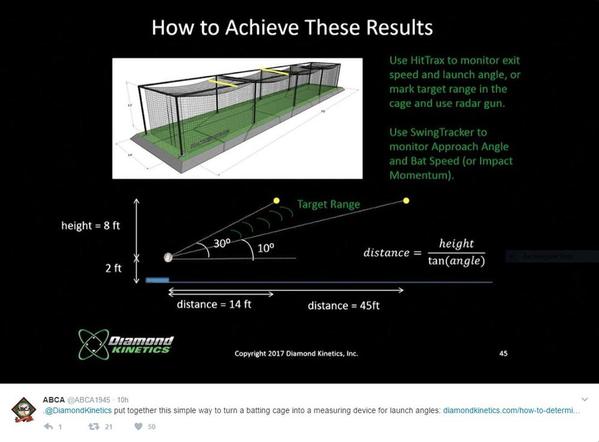just saw this on ABCA coaches feed.

And I guarantee you hit the top of the cage 14' in front of you and the tobacco spitters are gonna bust a gut screaming at you that its a pop up!
that is because with 90% of the HS kids swinging a BBcor it is a pop up - actually I would be willing to bet it is for more then 90% of HS kids.
You have to use logic while evaluating stats...
You only need 80 mph of exit velocity for that ball to go 300 feet. Certainly not a pop out and maybe a double in the gap. A fly out if hit at a fielder. 90mph gets you 350 feet. A home run in a lot of high school fields except for the deepest part of the field. Still probably an extra base hit unless hit to absolute straight away cf and he can get back to it. For it to be a pop up it would have to be like 50mph or something. If you can't deliver 90mph exit velocity in game (equal to high 70's off the tee) then you should not be a varsity high school player. Come on old school be honest - high 70's off the tee - don't tell me every high school varsity player should not be able to do that!
OK, I guess I'll crawl in and take another stab...
There are plenty of other data points that would question some of your numbers. Per below, in 2013 at Jupiter, where the level of play was VERY high, the ten longest HR's came with an average exit speed of 95-96 MPH - this was off of pitched balls, not a tee. To say that you don't belong in varsity HS if you can't deliver 90, I would say is quite a stretch. I would love to see a broader set of numbers with average HS players as opposed to only those at the high profile events or from training camps where the cross-section is certainly above the average HS player.
http://www.efastball.com/artic...t-speeds-at-jupiter/
Additionally, there are other charts that state you need something closer to 95 -100 MPH to achieve any consistency of 350' distance... and of course, there are other factors involved in the equation.
http://www.efastball.com/hitti...-speed-by-age-group/
Also, spin rate is a BIG factor. You need backspin for max carry. This means that your actual swing plane must be lesser than the resulting launch angle. So, to teach a swing that matches the desired launch angle is counter-productive from a distance standpoint. Also, when you try to teach an average HS player to specifically try and impart backspin (thus, implying "hit slightly below the center of the ball"), there will be far more misses under the ball and far more undesirable pop-ups.
Look, we know you have a big kid and that approach may turn out to work great for him but I will continue to argue strongly that it won't for the majority of HS players... while I spit my seeds.
We had one of our first days of on-field hitting this past weekend and we have a few more big kids with pop than usual. And, as with every year, the first time out on the field, the kids tend to reach for a little extra distance and tip it up. Once again, there were countless oohs and ahhs at contact, only to see most of the balls tracked down without too much effort by OF shaggers. A few days later, we got serious about our line drive approach and saw FAR more hits that would result in hits. This plays out year after year after year.
With the three decent pop guys I have, I know that one will be fine with some intent to lift, while the other two will lose productivity if they don't take more of a "barrel level thru the zone" approach (and, again, the desired result to this approach is a barrel plane that is actually very close to the plane of the pitch). Almost every contact at all levels is a slight to very slight miss. Using "solid thru the center of the ball" mentality provides the most reward.
JMO. Spit. Spit.


